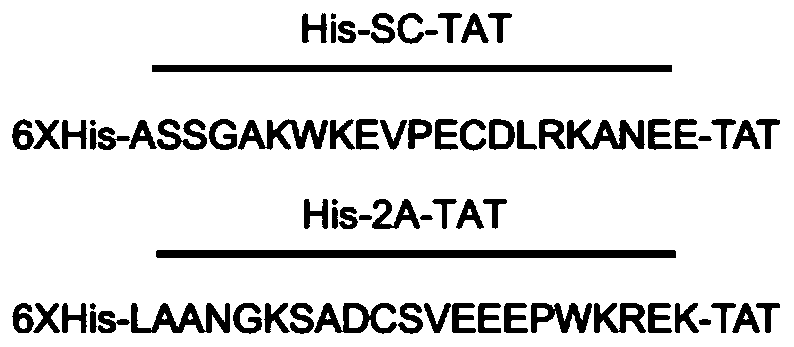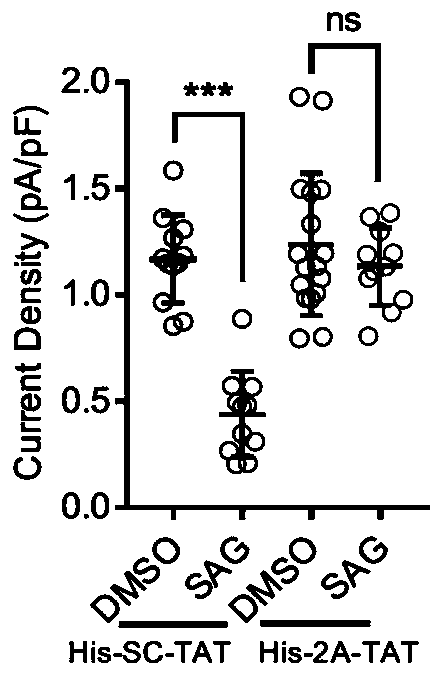Oligopeptide and application thereof
A short peptide and sequence technology, applied in the field of short peptides and their applications, can solve problems such as difficult clinical transformation
- Summary
- Abstract
- Description
- Claims
- Application Information
AI Technical Summary
Problems solved by technology
Method used
Image
Examples
Embodiment 1
[0030] Example 1 The effect of His-2A-TAT on the activity of glutamate transporter GLT-1 caused by SHH signaling pathway
[0031] Prepare short peptides His-2A-TAT and His-SC-TAT by biological or chemical methods, the amino acid sequence of which is:
[0032] His-2A-TAT:HHHHHHLAANGKSADCSVEEEPWKREKYGRKKRRQRRR;
[0033] His-SC-TAT:HHHHHHASSGAKWKEVPECDLRKANEEYGRKKRRQRRR.
[0034] structured as figure 1 As shown, His-SC-TAT was used as the control peptide of His-2A-TAT to verify the function of His-2A-TAT. The SC sequence is a random scrambled arrangement of the 2A sequence.
[0035] First, dissolve the chemically synthesized His-2A-TAT and His-SC-TAT powders with physiological saline to a concentration of 1 mM, and add His-2A-TAT or His-SC in proportion to rat astrocytes cultured in vitro -TAT, the total concentration is 0.5 μM and 1 μM. After 4 hours, the cells are lysed with cell lysate, heated at 100 degrees Celsius for 10 minutes to denature the protein, and the denatured...
Embodiment 2
[0039] Example 2 His-2A-TAT inhibits the reduction of GLT-1 protein on the cell membrane during cerebral ischemia
[0040]The results of Example 1 confirmed that the SHH signaling pathway can rapidly regulate GLT-1 activity in cells cultured in vitro. Whether there is activation of the SHH signaling pathway in the process of ischemia in the body, for this reason, a mouse unilateral cerebral ischemia model is constructed by inserting a thread into the right carotid artery of the mouse and tethering it to the middle cerebral artery. At different time points after ischemia, take out the hippocampal tissue of the ischemic side and the ischemic side of the mouse, and infiltrate the tissue in artificial cerebrospinal fluid for 30 minutes. If the SHH protein is secreted outside the cells, it will dissolve under such conditions. After that, the artificial cerebrospinal fluid was used for ELISA (enzyme-linked immunosorbent assay) experiment, and the results were as follows: Figure 5 ...
Embodiment 3
[0043] Example 3 Evaluation of the efficacy of His-2A-TAT in the mouse model of cerebral ischemia
[0044] The experimental process is as follows Figure 7 As shown, the C57 mice purchased from Speifu, with a body weight of about 25g, were randomly divided into 10 mice in the control group (His-SC-TAT), 9 mice in the treatment group (His-2A-TAT), and 1 hour before the experiment Inject His-SC-TAT or His-2A-TAT into the tail vein according to body weight (10 mg / kg), and perform unilateral cerebral ischemia modeling as described above. Two hours later, pull out the thread tie inserted into the middle cerebral artery, and restore the brain Blood flow in the middle artery was achieved to achieve reperfusion. One day later, the brain was taken out, sliced, and soaked in TTC staining solution (a commonly used reagent for detecting the activity state of brain cells) until red color appeared. Remove TTC, add PFA, fix at 4°C, and store.
[0045] The result is as Figure 8 As shown, ...
PUM
 Login to View More
Login to View More Abstract
Description
Claims
Application Information
 Login to View More
Login to View More - R&D
- Intellectual Property
- Life Sciences
- Materials
- Tech Scout
- Unparalleled Data Quality
- Higher Quality Content
- 60% Fewer Hallucinations
Browse by: Latest US Patents, China's latest patents, Technical Efficacy Thesaurus, Application Domain, Technology Topic, Popular Technical Reports.
© 2025 PatSnap. All rights reserved.Legal|Privacy policy|Modern Slavery Act Transparency Statement|Sitemap|About US| Contact US: help@patsnap.com



